
Scaffolding Moshi Style
|
Come 6am it was still dark, but by the time we had all showered, the morning had broken, and we went off to the Union Cafe for a delicious breakfast outside on the verandah. In the cool early morning some people were already pushing carts, and carrying goods in arms, on backs or on heads to the markets. Huge bunches of bananas and other fruits, bags of nuts, textiles, tubs of unknown liquids, tins of nails, boxes of eggs, shoes and countless other items were being trudged along paths as they had been doing over the last umpteen decades. The local militiaman paraded up and down with his antique rifle, keeping a lazy eye on the proceedings.
By 07:30 we were back with Gladys, discussing final details, and agreeing on a slight modification to our itinerary in order to allow us more time in the Serengeti. Dumping our surplus kit in Gladys's lockup room, we just took our essentials for the five day safari, and soon we were ensconced in our 4x4 and weaving our way out of Moshi with our driver and guide, Kepha, and our chef, Erasto.
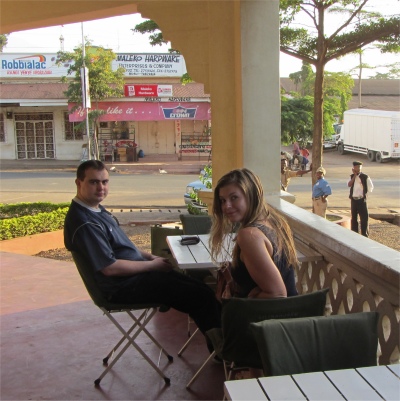
Dan and Sally at Union Cafe
|
We drove endlessly along a sealed road, heavily populated by very large sleeping-policemen. There were no speed limit signs along the highway, and these Maginot Lines were the only means of enforcing speed limitations through towns and villages.
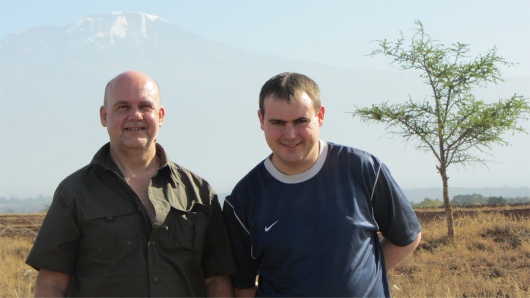
Me, Dan and Kilimanjaro
|
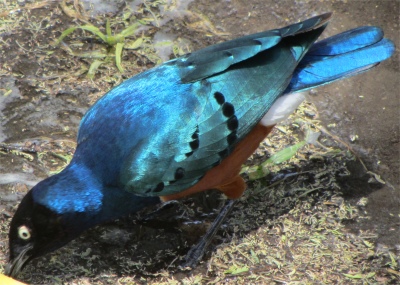
Superb Starling
|
In the still, clear morning air, we had a clear view of Kilimanjaro, geologically quite a young mountain, having been created during massive eruptions about 750,000 years ago. The peak lies 336km south of the equator and stands on Tanzania's northern border with Kenya. With a base larger in area than Greater London, and rising 5895m above sea level, it is said to be the highest free-standing mountain in the world. However, its presence was unknown to the west until 11th May 1848, when the German missionary Johannes Rebmann fancied he saw a dazzling white cloud on the summit of the huge mountain. His guide laconically told him that the cloud was
baridi - cold. Rebmann then realised that he was actually looking at snow. His reports were ridiculed by distinguished geographers back in England. The idea of a snow-topped mountain just south of the equator seemed absurd. It was over 40 years later when Dr Hans Meyer and an alpine guide, Ludwig Purtscheller, became the first men to scale the peak.

Vevet
|
Mount Kilimanjaro rests in breath-taking isolation from the surrounding coastal scrubland. To the west, beyond farms and fields of coffee, the dark pyramid of Mount Meru towers above Arusha National Park. Beyond Meru a volcanic landscape sweeps up to the Kenyan border and down towards the Rift Valley. South of the two great mountains stretches the so-called Maasai Steppe, with Tarangire National Park in its northwest corner.
Our route took us through a gently undulating, lush, landscape, initially heavily tilled, but after we passed Arusha it became a more savannah-like pastureland. Numerous small villages sat by the route, all lively and colourful, buzzing with folk engaged in activities, gossip, or sat by their laid out stalls of fruit, vegetables, textiles, building materials etc.
Between the settlements, large numbers of people walked as individuals or in small groups, either by the roadside or across endless fields. Large convoys of folk were marching alongside the road, all dressed in their Sunday best, and with children neatly turned out walking hand in hand. They were going to church. Sally explained to me that car ownership was only a far off dream for most people in this poor nation; the struggle to stay alive was far more important. Tanzania, despite a wealth of natural resources, is among the world's poorest countries.
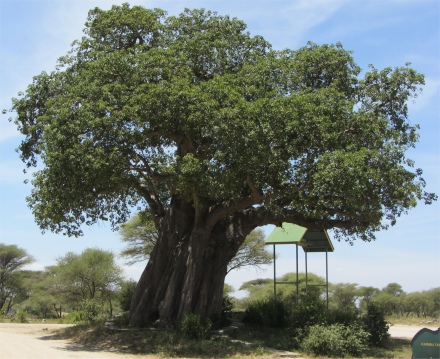
Baobab Tree
|
Many houses in small settlements were irregularly strewn on the bare ground, looking as if they had been nailed together with a bushel of four-inch nails. Some were brightly painted in eye-catching strong colours, with various messages stencilled upon them. Sally explained that many companies would supply people with free paint and stencils, for example a crimson coke colour paint and coke stencil, as a means of cheap advertising. That explained why I kept seeing lots of lime-green launderettes; really just advertising for a soap powder.
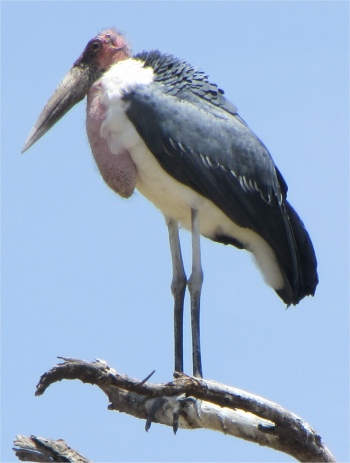
Marabou Stork
|
The sealed road eventually petered out to a track. We were now in Maasai country. The Maasai people of East Africa live in southern Kenya and northern Tanzania along the Great Rift Valley, on semi-arid and arid lands. They occupy a total land area of 160,000 square kilometres with a population of approximately one half million people. Now we often came across tribe members dressed in their traditional red kangas, spear in hand and wearing beautiful beaded jewellery. Periodically we would stumble across a group of young Maasai warriors, totally black apart from white markings on their faces, who were undergoing their 2 month plus stint away from their tribe after circumcision, the most important rite of passage in the Maasai society. Traditionally, circumcision initiation was a way to elevate an individual from childhood to adulthood. This rite of passage helped Maasai persons to find their place in the society.
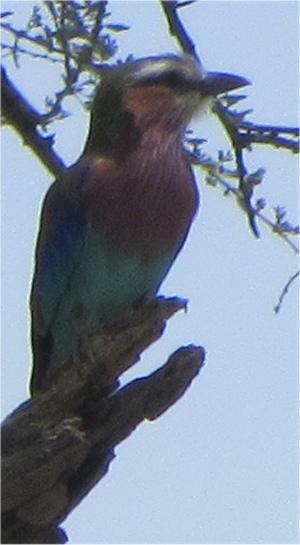
Lilac Breasted Roller
|
I observed on some of the trees we passed that several logs had been suspended horizontally from their branches. Kepha explained that these logs were hollow, and were actually beehives. Locals used the liquid gold to make mead.

Red Billed Hornbill
|
We had climbed to an altitude of 1250m, and the landscape was now becoming savannah, sprinkled with acacia and baobab trees. Kepha pulled into what appeared to be a large truck stop area, without the trucks, and Erasto transferred boxes and himself to another vehicle. He was going straight to tonight's campsite, while we drove off to explore the Tarangire National Park with Kepha. Taking a turn-off, we headed down a long, straight sealed road, passing groups of Maasai by the roadside and solitary, small children tending herds of grazing goats.
This was effectively the start of our safari. The long drive down the sealed road gave me a chance to reflect on Tanzania. The country is a land holding impressive statistics, with an area of 945,087 sq. km, containing Mount Kilimanjaro, only 3 degrees south of the equator and the highest mountain on the continent towering to 5895m, and part of Africa's deepest lake, Tanganyika with a depth of 358m. These figures are matched by a rich topography, which ranges from mighty volcanic and ancient crystalline mountains to rolling tableland, from great lakes to seemingly endless grasslands, dense woodland to palm-fringed coral sands.
The land is riven north to south by the eastern arm of the Great Rift Valley, the western fork of which, in the shape of Lake Tanganyika, helps to form Tanzania's western border. The country's eastern border is determined by the Indian Ocean, and in the south by the Ruvuma River. The northern border with Kenya is more politically defined rather than natural.
Northern Tanzania is home to the Serengeti Plains, Olduvai Gorge and Mount Kilimanjaro. Of particular note in the northern region is the vast expanse of land set aside for national parks and wildlife reserves. These sprawling parks and reserves are among the most popular attractions in the country. An astonishing 25% of Tanzania's land area is given over to protected wildlife zones, and 20% of Africa's larger mammals are to be found in the country. The Big Five, as the old hunters knew them are: lion, leopard, elephant, buffalo and rhino. The abundance of wildlife, along with the annual migration of millions of animals across Northern Tanzania offers some of the finest wildlife viewing in Africa.

Juveniles - We Can See For Miles and Miles
|

These Feathers Are Not For Sale
|
Although Tanzania has an admirable record for creating wildlife sanctuaries, its reputation for conserving them, as with so many other poor countries, has not always been so good. Poaching for ivory and horn in the late 70s/early 80s almost wiped out the elephant and rhino populations. Poor morale and conditions among wardens, rangers and game scouts, lack of funding and resources, poor management and widespread corruption hindered control of the poaching. The situation has been reversed through committed staff of the National Parks and Game Department and the involvement of the Tanzanian Army. Concerns now include a greater need for land and sustenance, which leads to huge areas of land being deforested, mostly to provide charcoal for cooking or a great deal of money for dealers in tropical hardwoods.
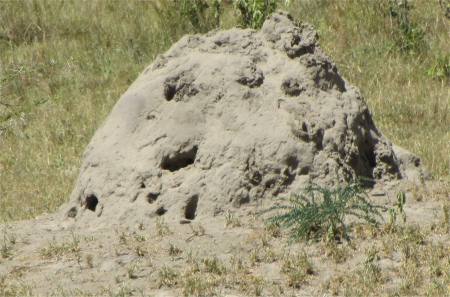
Termite Mound
|
Tarangire National Park is the sixth largest national park in Tanzania after Ruaha, Serengeti, Mikumi, Katavi and Mkomazi. The name of the park originates from the Tarangire River that crosses through the park, being the only source of water for wild animals during dry seasons, when thousands of animals migrate to the park from Manyara.
Lying a little distance to the south east of Lake Manyara and covering an area of approximately 2,850 square kilometres, Tarangire National Park offers a landscape and vegetation that is incredibly diverse, with a mix that is not found anywhere else in the northern safari circuit. The hilly landscape is dotted with vast numbers of baobab trees, dense bush and high grasses, with a large peppering of termite mounds.
Eventually we rolled into the entrance to the park, where we stopped for a picnic lunch. A murmuration of Superb Starlings hovered amongst tables hoping for crumbs, their plumage radiating a stunning iridescent blue when the light caught it. A small troop of vevets scampered around, one plucky enough to steal a titbit off a nearby table. This heinous crime galvanised a guide into action, who swiftly hurled a stone at the escaping thief, followed by a stream of what I could only assume to be Swahili curses.
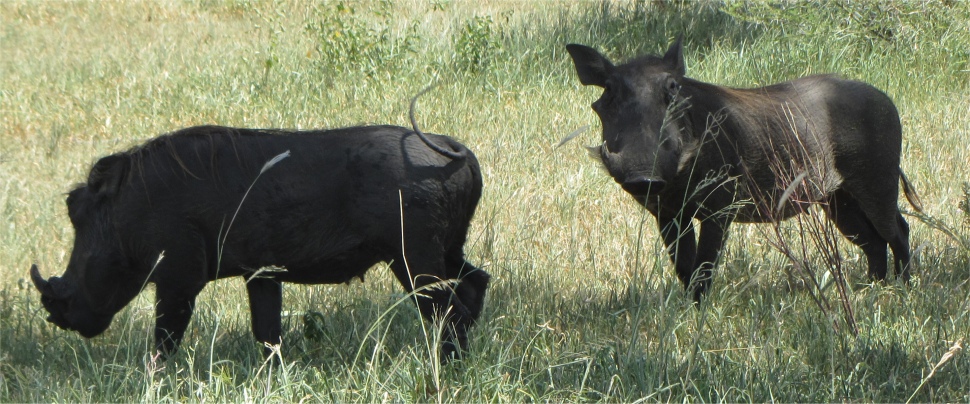
Warthogs
|
We meandered along a veritable maze of dirt tracks criss-crossing the park, through terrain ranging from short cropped grasses to lush havens near water holes and around the river. Kepha had mastered these trails over the seven years he had been on the job. Tootling along, seemingly oblivious to the world, he would spot a bird high up in a tree many metres away, or some creature well hidden in the grasses. He made the safari a delight for us, always full of surprises as we rounded each corner, stumbling across a tower of giraffes, a herd of elephants, a troop of baboons, warthogs, groups of gazelles with twitching tails, and so on. The delicious hot smell of dust, aromatic sage, dung and resin permeated the air. The sheer thrill and joy of seeing so many of these noble creatures in the wild, as they should be, was indescribable. This experience was a light-year away from seeing such creatures cooped up in a zoo, and seeing the joy on my children's faces brought a wee tear to my eye. All I can say to those reading this, who like me found visiting animals in zoos a wishy-washy experience, seeing the same animals in large numbers in the wild is a truly wonderful experience. At the same time it is a saddening experience when you dwell on man's cruelty to such beasts, and how we have almost eradicated some of them through the greed of some of our species. Seeing them roaming in the wild made me think that perhaps man has caged himself into his own world, but I shan't dwell on that philosophical concept here.

Impala
|
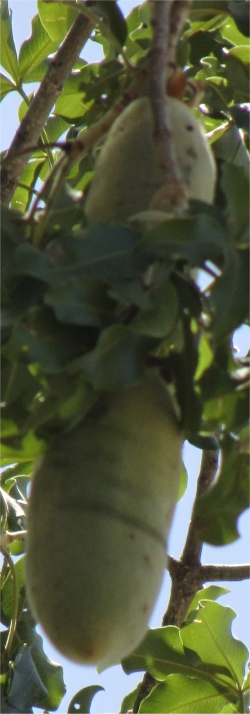
Baobab Fruit
|
We dawdled a while watching a large group of elephants with young (one almost a month old) ponderously head in our direction, wrenching out trunkful's of grass on the way to sustain their daily 160Kg intake. They majestically and purposely marched across the road and continued scything down grasses on their progression up the gentle slope. To see a large group of these creatures in the wild is quite moving. Being quite close, I could sense their sensitivity and gentleness, their family patterns and loyalty, and most of all their uncanny intelligence.
Warthogs gathered in small groups, watching with liquid eyes, soft muzzles sniffing, unafraid. Sally related in great amusement how she had seen a group running in Kenya, all with their tails up straight. The park seemed to be full of different herds of elephants. Within just a few hours we had shifted from the elation of seeing our first elephants in the wild to now being totally blasť about yet another crowd.
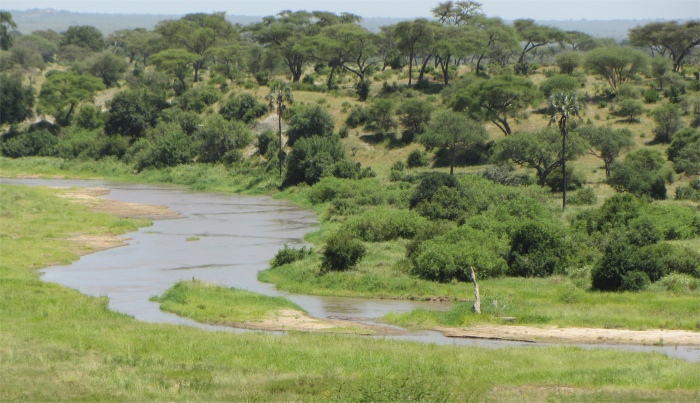
Tarangire River
|
A solitary lion stood proud on a small rocky outcrop, keeping a watchful eye on a litter of cubs exploring through the tall grasses. The parent observed motionlessly, then satisfied they weren't going to come to any harm, slowly padded off out of sight towards the river, no doubt to find a meal for the family.

Baboon
|
When we first encountered ostriches, the world's largest birds, Kepha explained to us how the male ostriches are territorial, defending an area and his female mates from other males. Although a male forms a breeding pair with a dominant female, he may also mate with other females within a herd. One male ostrich may mate with between two and seven females in a single breeding season. Before mating, males practice courtship rituals, which involve flapping and shaking their wings and tail rhythmically while lowering their bodies to the ground. The male then approaches the female with wings outstretched, and mating will occur if the female ostrich consents. Once they have mated, the male uses his strong legs to dig a shallow hole in the ground, which will be used as a nest. The dominant female ostrich lays her eggs in the center of the nest but the male's other mates will also lay their eggs in the same nest. The dominant female is able to identify her own eggs and ensure that they occupy the best position in the nest. These shared nests often contain about 25 eggs, although this number can vary because each female is capable of producing between two and 11 eggs. Ostrich eggs usually measure about 6 inches in length and weigh approximately 3 pounds. The male ostrich and the dominant female take turns to incubate the eggs for a period of six weeks. The male usually incubates the eggs overnight, his black feathers helping to form an almost perfect camouflage, and the female takes over and incubates them during the day. At this time, adult ostriches also guard the eggs from predators.

Out for A Stroll
|
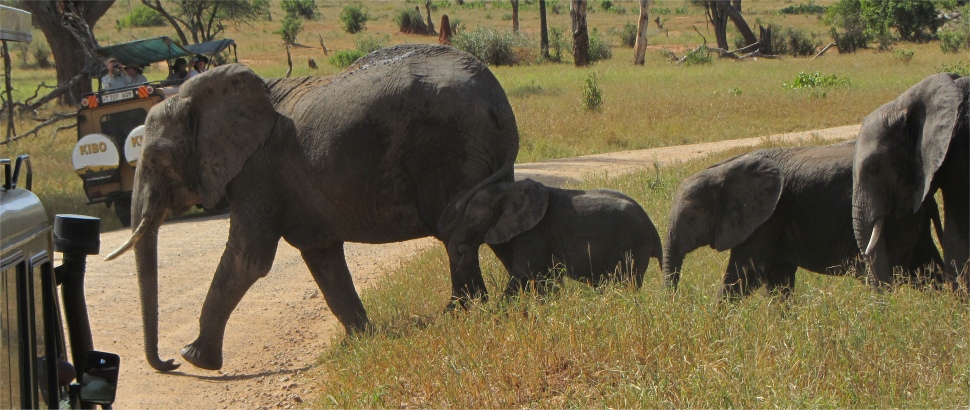
Who Has Right of Way - Youngest is 1 Month Old
|
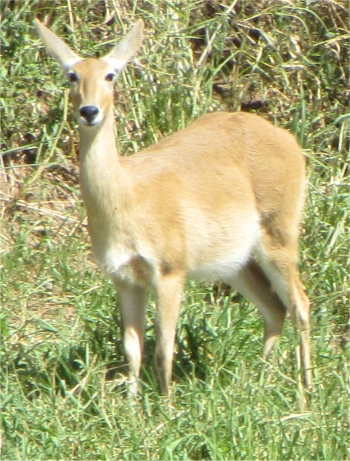
Reedbuck
|
All too soon we returned back to the park entrance, and soon we were heading along a never-ending road across the Great Rift Valley, skirting the northern end of Lake Manyara, passing through the colourful Mto Wa Mbu on the way. The name Mto Wa Mbu means Mosquito Creek. This small town does have a problem with mosquitos but it also a busy market town with local fruit and vegetables for sale. The central market sells arts and crafts as well as fresh food. The backdrop for Mto Wa Mbu is palm, baobabs and acacia trees framed by the Rift Valley escarpment.
Rift valleys differ from river valleys and glacial valleys because they are created by tectonic activity and not by the process of erosion. Rift valleys are created by plate tectonics, the Tectonic plates being colossal rocky slabs made up of the Earth's crust and upper mantle. They are constantly in motion-shifting against each other, falling beneath one another (a process called subduction), crashing against one another. Tectonic plates also tear apart from each other. Where plates move apart, the Earth's crust separates, or rifts. Rift valleys can lead to the creation of entirely new continents, or deepen valleys in existing ones.
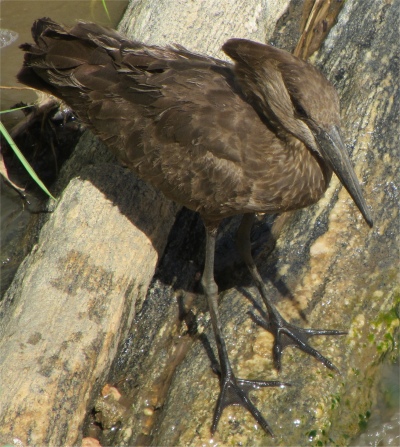
Hammercock Bird Looking For Fish
|
Africa's Great Rift Valley is a 10,000km-long rift that extends from Syria in south western Asia to Mozambique in south eastern Africa. The land on either side erupted creating great volcanic mountains, while the valley floor gradually sank into a low flat plain. This geologic phenomenon, dubbed the Great Rift Valley by the Scottish explorer John Walter Gregory, divides Kenya neatly down the length of the country, essentially separating east from west. Today, The Rift Valley is characterized by uninhabitable desert and fertile farmland, flat arid plains and steep escarpments. The Great Rift Valley is also the home to millions of wildlife and hosts the worlds most renowned game parks and reserves: the Maasai Mara in Kenya and the Serengeti in Tanzania.
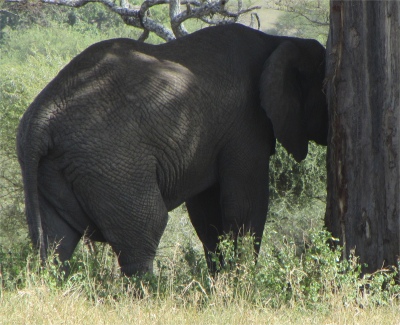
Stripping Off Baobab Bark
|
A steady climb up the steep slopes of the western flank of the valley brought us to a viewing point overlooking Lake Manyara. The lake was formed between two and three million years ago when streams poured over the valley wall after the Rift Valley was formed. The lake was probably at its largest 250,000 years ago but in recent years the lake levels are falling. Today the water was at a low level, so it was more of an expanse of mud flats leading out to the grassy floodplain. The area was famed for its tree-climbing lions, as well as the flamingos and other fascinating birds which can be seen in impressive numbers on and around the shallow, alkaline lake.
Our original itinerary had included a stop off at Lake Manyara, but our revised itinerary traded a stop-off at the lake for extra time in the Serengeti; probably a better option. The high level view we were treated to would suffice.
Looking back over the Rift, we could see that we had crossed it at a point where the eastern walls had been levelled off, so it was difficult to get an impression of a valley. Nevertheless, it was a stupendous, breath taking sight stretched out far below us, and a sobering thought to think that here we were, at one with our ancestors, insignificant specks standing on the brink of a 10,000km rift in the earth's crust, part of the "Cradle of Mankind".
We left our eyrie, and headed across a high plain, obviously Maasai country judging from the traditional costume being worn. Herds of cattle and goats were in abundance, another trademark of the Maasai. At intervals we came across roadworks, signalled by mounds of gravel stretching across the roadway, makeshift sleeping policemen, which were shortly followed by detours over dusty dirt tracks.
|
Lake Manyara in the Distance from Viewpoint on Western Flank of Great Rift Valley with Kepha Being Eaten by Bush (please use scroll bar)
|
Then, without warning, our driver turned off and we climbed up a dirt track. The trail brought us up to Havennature Safari Camp. The camp sits above the road to Karatu west of the Lake Manyara overlook. It was predominantly focused for large groups of campers, and offered shared restroom and shower facilities located near the pre-erected tents.
Kepha guided us through a group of communal eating areas, each having a high roof thatched with banana leaves, and containing several tables. Some of these were already occupied by groups of young folk of varying nationalities, all excitably chatting about the wonders they had just seen or were about to see. He showed us our table, and advised us to be there by 19:30 for a meal freshly prepared by Erasto. "There is tea and coffee already on the table. Just help yourself to it anytime you want," he said, and with that he left us with a young man who showed us to our tents. The tents were quite roomy, and equipped with beds, mattresses, pillows and sheets. What more could we ask for?

Dan, Sally and I with Lake Manyara in Background
|
Darkness rapidly fell, and a breeze picked up by the time we sat down to eat with Kepha, which was good since breezes keep mosquitoes at bay. Erasto had prepared for us a delicious leek soup, followed by fish, side salad and potatoes, with a mboga vegetarian dish for Sally, and finally fruit for dessert. Sally had brought a bottle of Amarula, a cream liqueur made from a blend of the unique fruit from the marula tree and cream. We enjoyed the moorish drink with Kepha as we discussed with him the state of Tanzania, the intertribal politics in the country, and its uneasy relationship with Kenya. China and the U.S. are making their presence felt in Kenya, particularly since oil had been found near the Sudanese border. This area was still very tribal and lawless, and Sally reported how one tribe had lured a number of police into a valley in the region and massacred 47 of them.
We learned a little of Kepha over the meal too. He was a Maasai, with a name taken from the Bible, and he had grown up in Arusha, learning English in school. After training, he had been working as a safari guide for seven years, and he also had a one year-old daughter named Nicolle. Kepha had travelled extensively throughout Africa, but never outside it, and like all Africans, was an avid follower of English football. It was always on Tanzanian T.V., and the fellow was proud to announce that he supported Manchester United. Hmmmm....... how many English folk support Azam FC, JKT Ruvu Stars or Kagera Sugar?
We had grown to like Kepha, his easy going attitude, energy, humour, knowledge of the job in hand, patience and his wisdom. He, like all safari guides, shared meals with us, and we would get to know him better as the safari progressed. Sadly, we did not see much of Erasto. Like all chefs, he spent time in the communal cookhouse preparing meals, and when we were together, he did not have the command of English that Kepha had. But he was a happy, cheerful soul and complimented Kepha with his good sense of humour. He worked miracles in the kitchen with the box of food he had brought with us that lasted the full five days, and his small cooking stove. We were highly impressed with the quality and quantity of the food he prepared, and he deserved to be called a chef.
Anticipating the early start in the morning, we retired early for the night. In the background, drumming and chanting could be heard. "Maasai are putting on a demonstration further down the hill," explained Kepha. Sally recounted how she had often heard drumming in the village where she had lived in Kenya. Sometimes the drumming would last all night, an indication that someone had died.
The silvery crescent of the moon sailed up over the horizon and traversed the invisible, inky blackness below.
|
Last updated 1.4.2013
























